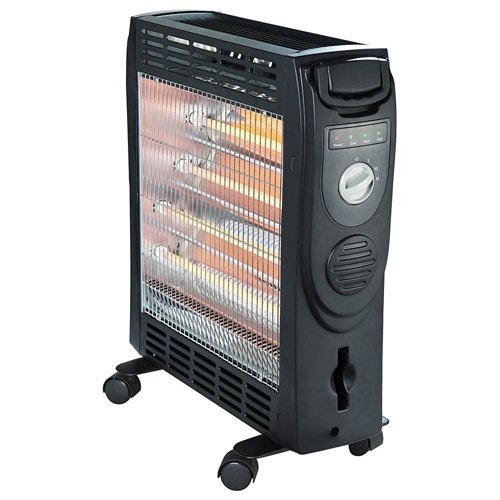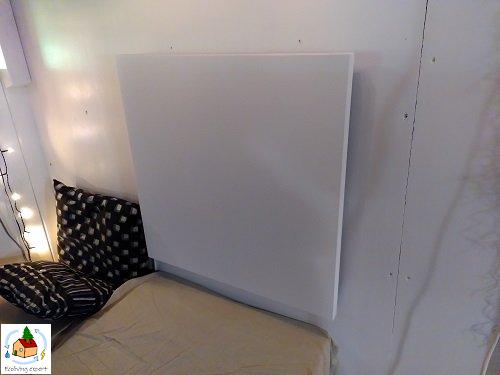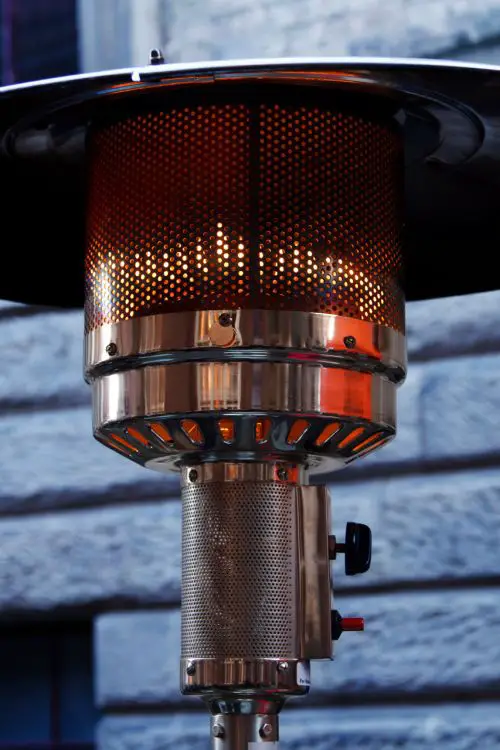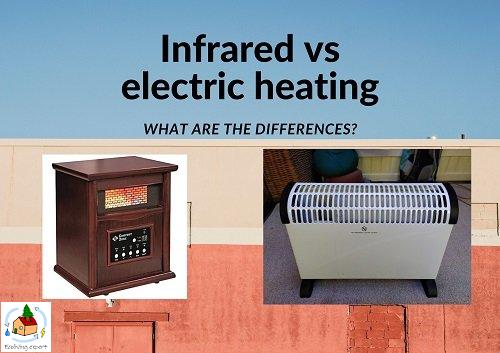The main difference between an infrared heater and an electric heater is how they distribute heat. Electric heaters warm the air while infrared heaters heat objects and people directly through radiation. Infrared heaters use 40% less energy and therefore cost 40% less to run
Both electric heaters and infrared heaters work on electricity. They differ in their way of distributing the heat. Electric heaters use convection, which means they heat the air in the room. Infrared heaters use radiation, which means they send out warm rays similar to the sun.
Electric heaters create the same heat you are used to when you are indoors. Infrared heaters feel similar to sunshine. The air is not heated, but you and the objects in your room are heated as if they were bathing in sunshine.
The differences between electric and infrared heaters
There are several differences and similarities between both types of heaters.
Differences
- Radiation vs convection heating
- Air heating vs object heating
- Infrared heaters use 30-40% less energy for the same level of comfort
- The running costs of infrared are 30-40% lower
- Infrared heating does not dry the air
- Infrared heating does not circulate the air
- It takes time for air heating to warm up the room. Infrared is felt instantly
- Infrared is suitable for outdoor use
- Fans on electric heaters as well as some infrared heaters make noise, while infrared panels and patio heaters are perfectly quiet
Similarities
- Both run on electricity
- They are available as small portable heaters
- Both are available up to 1500 Watts
- They are available in similar-sized portable heaters


The picture above shows my 2000W electric convection heater. I currently use it to supplement my two infrared heating panels. The picture on the left shows a typical portable infrared heater.
Infrared heaters are more effective heaters
Since infrared heaters will directly heat you and the objects in the room, they use less energy than conventional heaters to create the same level of comfort.
Normally, an electric heater or central heating system start heating the whole room by warming up the air. This warm air rises to the ceiling, and it takes a while for the warmth to reach the desired places. Next to that, warm air is easily lost by a draft or the opening of a door or window.
Infrared heaters do not have these issues since they send infrared rays that heat people and objects directly. This work very similar to sunshine. When you are in the sun or in range of the infrared heater, you feel the warming rays.

Infrared uses 40% less electricity
Since infrared heaters are such effective heaters, they require 30 to 40% less energy to create the same level of comfort as conventional heaters. No energy is lost in heating the air at your ceiling and no energy is lost due to drafts.
Conventional air-warming heaters use about 10 watts to heat one square foot. Infrared heaters require only 7 watts.
However, not every room requires the same amount of heating. For example, a relatively low temperature is preferred in the bedroom.
The following table shows the required wattage per room for infrared and regular heaters.
| Area | Infrared heating: wattage per sq. ft (0,1 m²) | Regular heating: wattage per sq. ft (0,1 m²) |
|---|---|---|
| Living room | 7 W | 10 W |
| Bedroom | 4.5 W | 6.3 W |
| Bathroom | 9.3 W | 13.3 W |
| Closed porch | 9.3 W | 13.3 W |
| Open outdoor area | 28 – 56 W | Warm air cannot heat an outdoor area |
Infrared is suitable for outdoor heating
Of course, a regular air-heating heater cannot heat an open outdoor area. Some infrared heater, however, are able to warm outdoor areas because they heat people and objects. An example of an outdoor infrared heaters is the commonly known terrace heater.

Is infrared cheaper than electric heating?
Both infrared and electric heaters run on electricity. Therefore, the price of one kilowatt-hour (kWh) of energy usage is the same. In the US the average electricity price is 13.31 cents per kWh. However, since infrared heaters use 30-40% less energy for the same level of comfort, your energy bill will be 30-40% lower.
The following table shows the costs of running an infrared vs an electric heater. The assumed room is a living room of 330 square feet. This requires approximately 3300 watts for an electric heater and 2310 watts (30% less) for an infrared heater.
| Time | costs infrared heating ($) | costs electric heating ($) |
|---|---|---|
| One hour | 30.6 cents | 44 cents |
| Day (6 hours) | 1 dollar and 84 cents | 2 dollar and 64 cents |
| Week | 12 dollars and 86 cents | 18 dollar and 45 cents |
| Month (30 days) | 55 dollars | 70 dollars |
I wrote an in-depth article about the running costs of infrared heating. You can find it here: The real running costs of infrared heating.
Noise: infrared vs electric heating
Infrared space heaters sometimes come with a fan that makes a little bit of noise. However, the sound level is normally only around 40 dB. This is as loud as rustling leaves or a quiet library.
Other types of infrared heaters such as panels or patio heaters do not make any sound.
Electric heaters almost always have a fan and will produce some level of sound, depending on the model. A common level of noise is about 60 decibels, which is similar to a conversation. Lower decibel levels are considered quiet for an electric heater. The lowest level of decibels you will find will be around 35 decibels, which is more like rustling leaves.
Infrared vs electric heaters: pros and cons
Although infrared heaters use less energy than conventional electric heaters, there are some differences that you need to consider before purchasing one or the other.
Infrared heaters have some disadvantages
Infrared heaters do have some disadvantages that you need to consider.
- Infrared heaters leave the air relatively cold
- Infrared heaters must not be obstructed by other objects
Infrared heaters leave the air relatively cold
Infrared heaters only heat people, and objects that are in sight of the heater. Therefore, the heat is not evenly distributed around the room. And since these heaters do not warm the air, areas that are not heated feel relatively cold.
Infrared heaters are perfect for zone heating and will save on your electricity use. However, if you want to heat every nook and cranny of your house, you will likely want to supplement with an air-heating system. This can be an additional electric heater (I have one for use during the winter) or using your central heating system.
Infrared heaters must not be obstructed by other objects
Since infrared heaters send out infrared rays through the room, heating anything they hit, they require some open space around them. For example. if you would place an infrared heater just behind the couch, only the back of the couch would be heated.
Mounting infrared panels to the ceiling is preferred as this ensures that the infrared can freely beam through the room. For wall-mounted or portable infrared heaters, make sure to place them unobstructed and facing toward the area that requires heating.
Although infrared heating is not perfect, there are way more advantages than disadvantages. For example, infrared heating helps maintain healthy indoor air.
I wrote an article that goes into depth about all the pros and cons of infrared heating. You can find it here:
Electric heater disadvantages
Air-heating electric heaters have some disadvantages that you need to consider before purchasing.
- Electric heaters dry the air. This can result in discomforts such as dry eyes, a sore throat, and respiratory issues.
- Electric heating can lead to poor air quality due to increased air circulation
Electric heaters dry the air
When the air is heated, it also becomes dryer. This can lead to dry-air-related discomfort. Symptoms of dry air are a sore throat, dry eyes, a constant feeling of thirst, and respiratory issues.
Infrared heaters do not have this issue because they do not dry the air.
Electric heating can lead to poor air quality
Since the air is heated, the warm air starts to rise to the ceiling. This leads to air movement around the room. However, this also means that unwanted tiny particles such as dust are circulated around the room. This can greatly reduce indoor air quality.
Poor air quality is a serious problem that can lead to symptoms such as headaches and fatigue. Long-term exposure can lead to diseases such as respiratory disease or cancer. If you are interested in reading more about indoor air quality, I recommend reading my article: The complete indoor air quality guide for your home.


